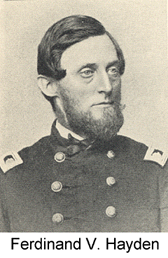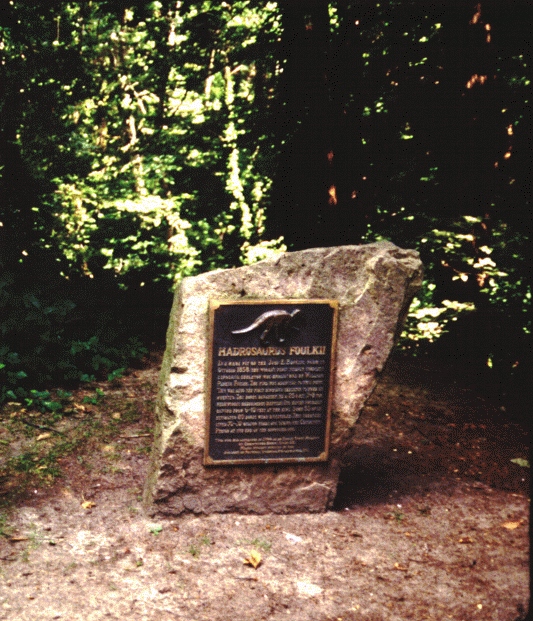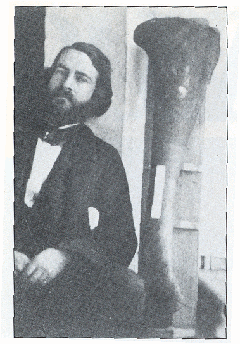

 | JOSEPH LEIDY: In Europe, by the mid-19th century, dinosaurs had not only been identified and named, they were becoming well known to the general public as well as to science. On this side of the Atlantic, however, there was only a void. Apart from Hitchcock's trackways, which were still considered to be made by birds, no American dinosaurs had been as yet described. Joseph Leidy (1823-1891) changed that, and initiated a century and a half of work on American dinosaurs that transfigured dinosaurs, and made them the familiar animals that they are today. Leidy was a scientist of unusually wide interests, and was in many ways the American counterpart of Richard Owen in England, but without Owen's aggressive egomania. Leidy also embraced Darwin's new ideas on evolution so that his star did not fade, as did Owen's, following publication of Origin of Species in 1859. Leidy was first and foremost a professor of anatomy at the University of Pennsylvania in Philadelphia, but he also was an accomplished zoologist, parasitologist and mineralogist, and was a major figure at the Philadelphia Academy of Sciences. |
 | However it is as a paleontologist that he is important here. Leidy's first contribution to dinosaur paleontology was made in 1856, when he published a paper in which he described fossil teeth sent to him from Judith River, Montana, by F.V. Hayden, one of the early explorer-geologists of the American West, as being similar to the teeth of Iguanodon and Megalosaurus. These were the first American fossils to be identified as dinosaurian. One of Leidy's new species, Troodon, is still a valid species name for the small carnivorous dinosaur that Leidy named on the basis of the teeth alone. |
 | Leidy's most important contribution, far outweighing anything else he did in dinosaur paleontology, was based much closer to home than Montana. From colonial days, farmers in southern New Jersey mined the phosphate rich glauconite marls that cover much of the southern part of the state as fertilizer for their fields. John Hopkins, of Haddonfield, NJ, now a suburb of Philadelphia, but then a rural farming village, was one of these farmers. About 1840 large bones had been found in the marl pit on his farm. William Parker Foulke, a well-to-do Philadelphia summer visitor to Haddonfield heard about this find and in 1858 persuaded his neighbor to allow him to re-open the marl pit to search for more bones. It wasn't long before Foulke and his diggers found what they were looking for. Leidy was called out from Philadelphia to take a look. What he saw was a large part of the skeleton of a dinosaur similar to Iguanodon but with a prominent flattened jaw that made the skull resemble the head of a giant duck. It was the first of the now well-known "duck-bill" dinosaurs to be discovered. More importantly, it was the first well preserved dinosaur discovered in North America. Leidy named it Hadrosaurus foulkii, and although the name of this species has recently been changed to Anatotitan foulkii, the term "hadrosaur" is still used as the name of the taxonomic group in which all duck-bill species are placed. Today, this discovery is commemorated by the plaque shown at the left, which was set up in 1991 by the State of New Jersey at the site of Hopkins' marl pit, and by the New Jersey legislature passing an ordinance naming Hadrosaurus as the official state fossil. |
 | Leidy immediately recognized the significance of this find, and beginning in 1858 he published a series of papers describing this new dinosaur. Having more of the skeleton to work with than previous workers, Leidy was able to demonstrate that Anatotitan stood erect on its back legs. It did not have the lizard-like, four footed stance that Owen and Hawkins had used in making their model dinosaurs a few years earlier. Leidy was thus the first to identify the bipedal posture that is a characteristic of most types of dinosaurs. The picture at left shows Leidy posing with a femur (thigh-bone) of his newly discovered hadrosaur. Hawkins visited Leidy when he came to America and he must have been influenced by Leidy considerably, because Hawkins' Central Park hadrosaur is depicted as being bipedal (see picture of Hawkins' Central Park studio). |
 | The New Jersey marls are now understood to be late Cretaceous marine sediments deposited along the Atlantic coast of Cretaceous North America. They contain a rich fauna of marine fossils, including: clams; oysters; snails; sharks; rays; bony fish; ammonoids;and squids, but the remains of land-dwelling animals like dinosaurs are rarely found in them. Although an occasional dinosaur bone fragment is infrequently uncovered, Leidy's find of a nearly complete large dinosaur skeleton has never been repeated in eastern North America. Apparently his specimen derived from an animal whose intact carcass was washed out to sea. Such an event must have been as rare then as it is now. The odds of finding an intact dinosaur skeleton in these beds can thus not be much different than winning the New Jersey state lottery. There are few paleontologists who don't know what the term "Leidy's luck" means. Today Leidy's hadrosaur can be seen at the Philadelphia Academy of Sciences where it is a centerpiece of the Academy's dinosaur exhibit. The picture at left shows this specimen as it appears now. |